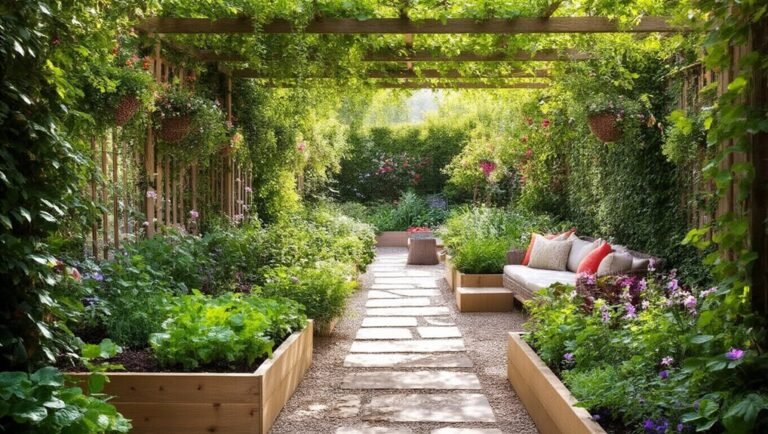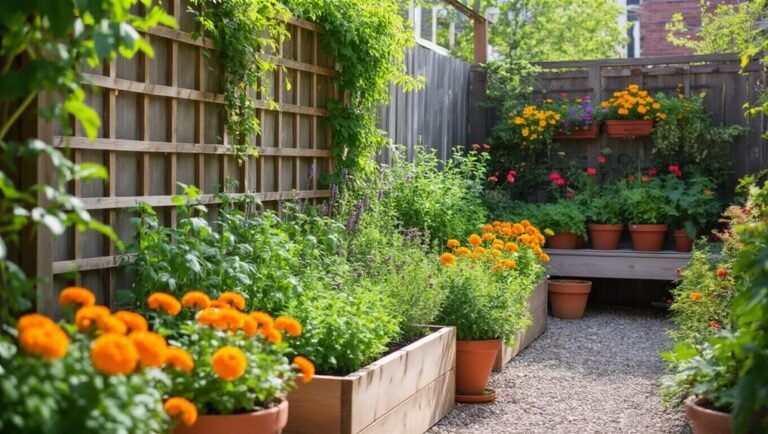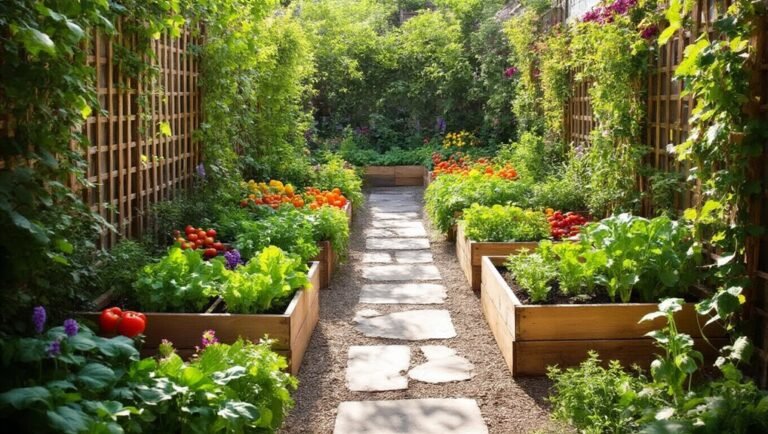To grow espalier fruit trees, you’ll start by choosing varieties like apples or pears that adapt well to pruning. Select a sunny spot with good air circulation, and install a sturdy support structure, such as a trellis, with horizontal wires. Train the central leader and prune regularly to maintain shape and promote healthy growth. Don’t forget to monitor for pests and diseases. There’s plenty more to discover about maximizing your space with this technique!
Key Takeaways
- Choose compatible fruit tree varieties like ‘Cox’s Orange Pippin’ and ‘Bartlett’ that thrive with pruning and training techniques.
- Install a sturdy support structure, such as a trellis or fence, ensuring it receives six to eight hours of sunlight daily.
- Regularly prune and train the central leader and lateral branches to maintain a flat growth pattern and promote healthy airflow.
- Monitor soil moisture to prevent overwatering, and apply appropriate fertilizers to support tree health and fruit production.
- Incorporate creative garden designs with pathways and seating to enhance aesthetics while maximizing the use of vertical space.
Understanding Espalier Techniques
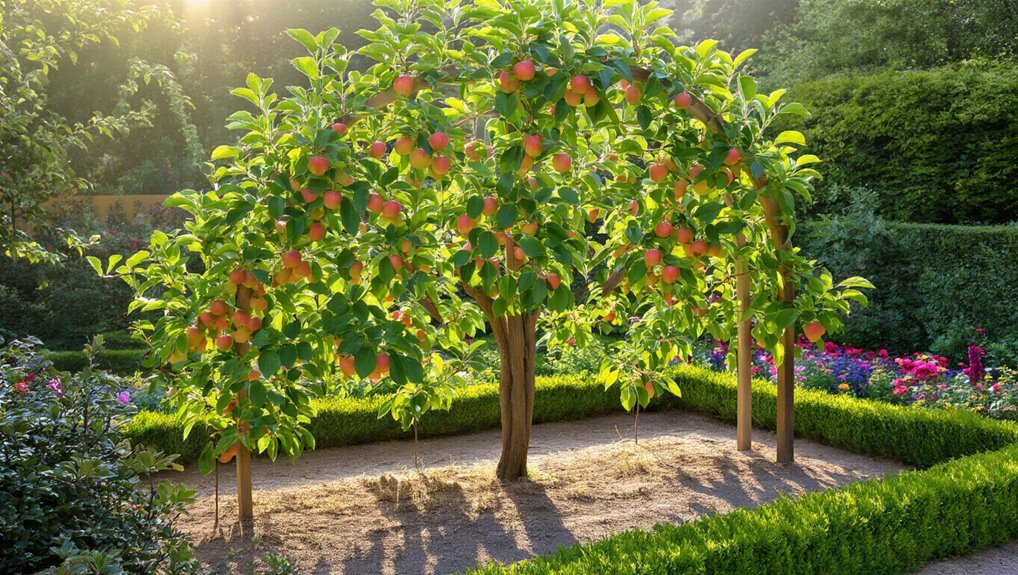
When you start exploring espalier techniques, you’ll discover that this method of training fruit trees not only saves space but also creates an eye-catching display.
Espalier involves pruning and tying branches to a framework, encouraging a flat growth pattern against a wall or fence. This technique maximizes sunlight exposure and air circulation, promoting healthier fruit production. Incorporating stunning arches into your design can further elevate the visual appeal of your garden while providing additional support for your espaliered trees.
It’s also a great way to manage tree height, making harvesting easier. To get started, select a sturdy structure, like trellises or wires, and choose your desired shape, whether it’s horizontal, vertical, or even fan-like.
Regular pruning and training are essential, so be prepared to invest time and effort. With practice, you’ll create a stunning, productive garden feature that delights both your eyes and taste buds.
For the best results, consider using beautiful trellises to support your espaliered fruit trees, as they provide both strength and an attractive addition to your garden.
Choosing the Right Fruit Trees
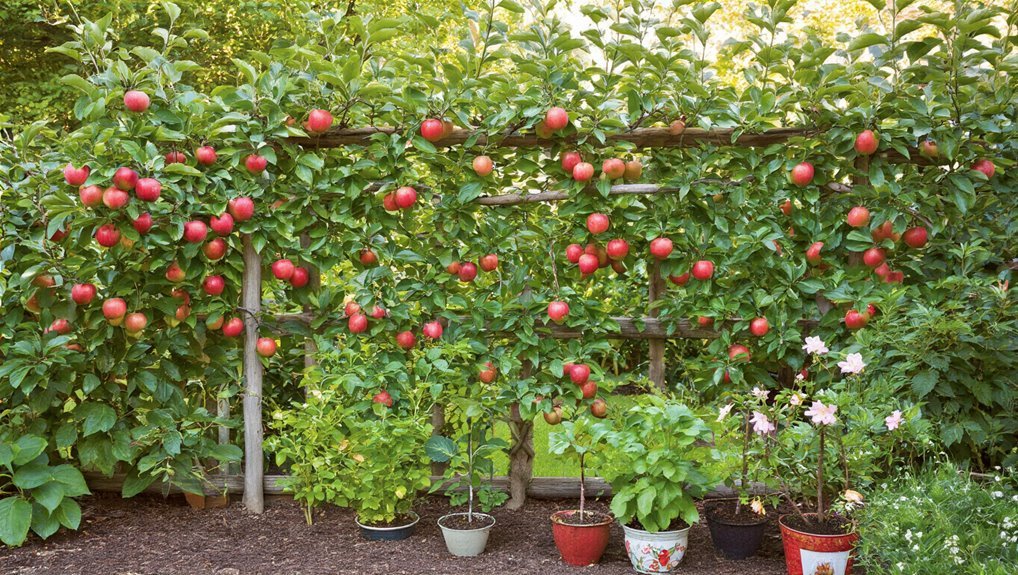
Selecting the right fruit trees is key to successful espalier gardening. You’ll want varieties that adapt well to pruning and training. Consider factors like climate, growth habit, and fruiting time. Here’s a quick guide to help you choose:
| Fruit Tree | Growth Habit | Best Varieties |
|---|---|---|
| Apple | Upright | ‘Cox’s Orange Pippin’, ‘Gravenstein’ |
| Pear | Spreading | ‘Bartlett’, ‘Bosc’ |
| Cherry | Upright | ‘Stella’, ‘Lapins’ |
| Plum | Semi-upright | ‘Methley’, ‘Santa Rosa’ |
For additional support, many gardeners also use tomato cages to help young espalier branches maintain their shape during the early stages of training. When working with sharp tools and branches, protecting your hands with gardening gloves is essential for both comfort and safety.
Selecting the Perfect Location
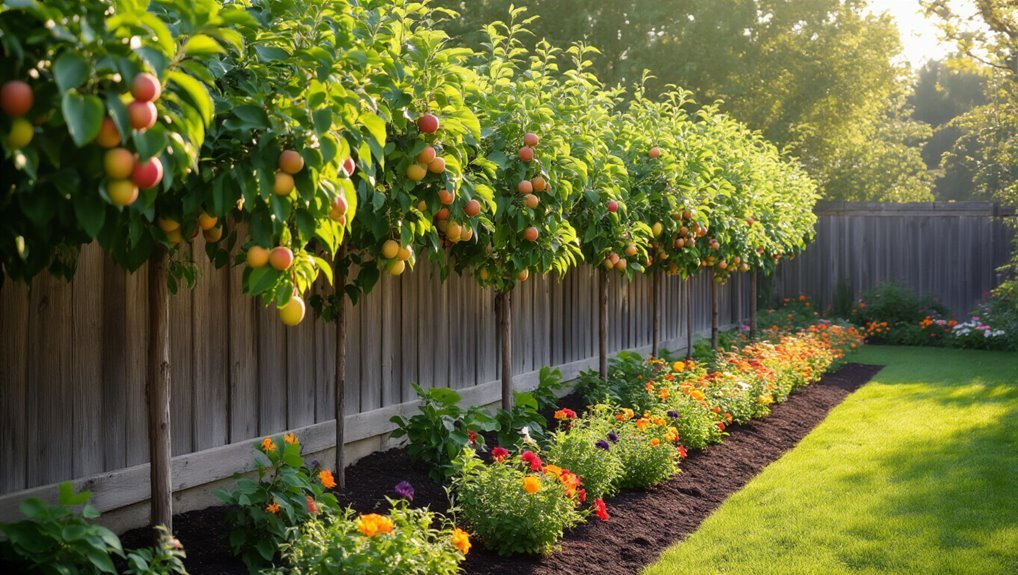
Where you position your espalier fruit trees can significantly impact their growth and fruit production. Choose a location that receives plenty of sunlight, ideally six to eight hours a day, since fruit trees thrive in bright conditions.
Avoid places with excessive shade from buildings or larger trees. Good air circulation is also crucial, so pick a site that isn’t too crowded. For optimal results, you may want to supplement your soil with plant fertilizer tablets to give your fruit trees the nutrients they need to flourish.
Well-drained soil is essential; if your ground retains water, consider raised beds. Additionally, think about accessibility for maintenance and harvesting—don’t put them too far from your home.
Lastly, ensure you have enough space for the trees to grow without obstruction, keeping in mind their mature size and spread. For the healthiest trees, use the best garden soil to provide nutrients and support strong root development.
Preparing the Support Structure
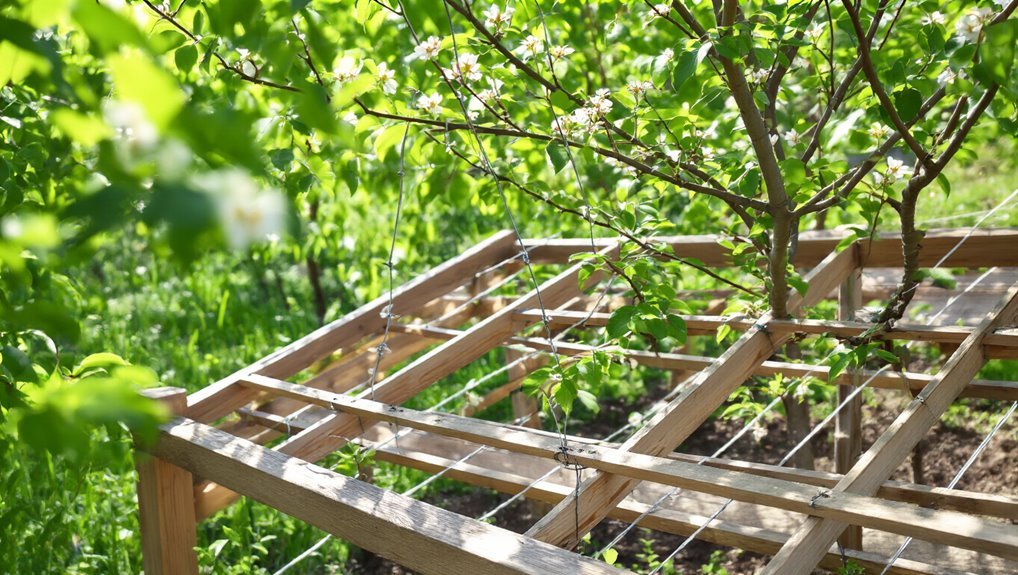
To successfully train your espalier fruit trees, you’ll need a sturdy support structure. Start by choosing between a trellis, fence, or wall. Make sure it’s at least six feet tall and can withstand the weight of the trees as they grow. Use durable materials like galvanized steel, treated wood, or heavy-duty wire. For easier transportation of soil, tools, or even young saplings while setting up your espalier area, consider using garden carts for convenience and efficiency.
Next, install horizontal wires or slats spaced about 12 to 18 inches apart, ensuring they’re securely anchored. If you’re using a wall, consider attaching wooden battens to create a framework for your branches.
Don’t forget to position your structure in a sunny location, allowing for proper air circulation and light exposure. This solid foundation will help your trees thrive and maintain their shape as they grow. For extra support and flexibility, consider using garden trellis netting to provide a reliable framework as your espalier trees develop.
Planting Your Espalier Tree
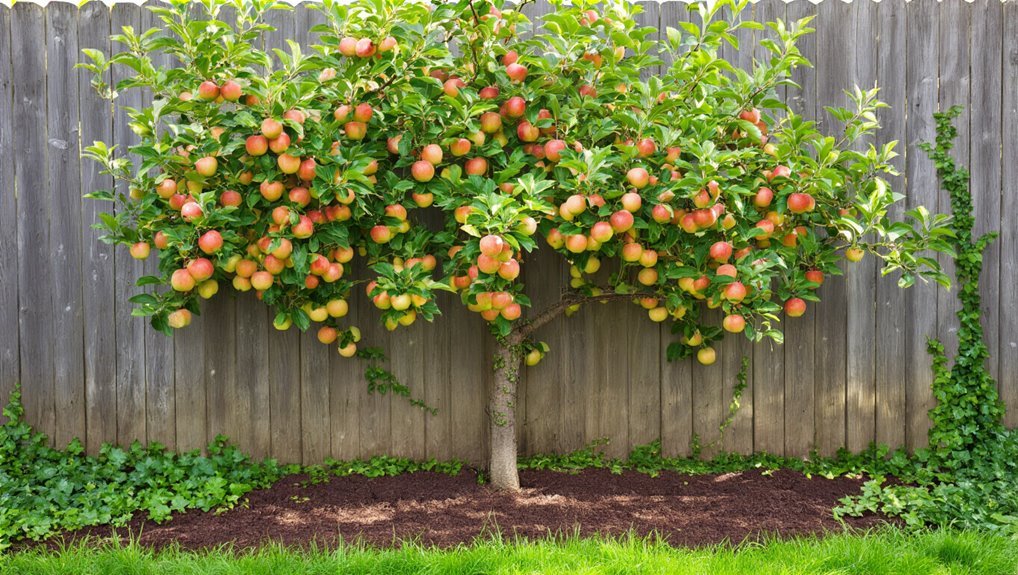
Once you’ve established your support structure, it’s time to plant your espalier tree. Follow these simple steps to ensure a healthy start:
- Choose the Right Location: Pick a spot with full sun and well-draining soil. Your tree will thrive if it receives at least six hours of sunlight daily.
- Dig the Hole: Create a hole that’s twice as wide and just as deep as the root ball. This allows the roots to spread and establish themselves easily.
- Position and Backfill: Place the tree in the center of the hole, ensuring it’s straight. Backfill with soil, gently firming it around the roots to eliminate air pockets.
Water your tree thoroughly after planting, and you’re ready to watch it grow!
Training and Pruning Techniques
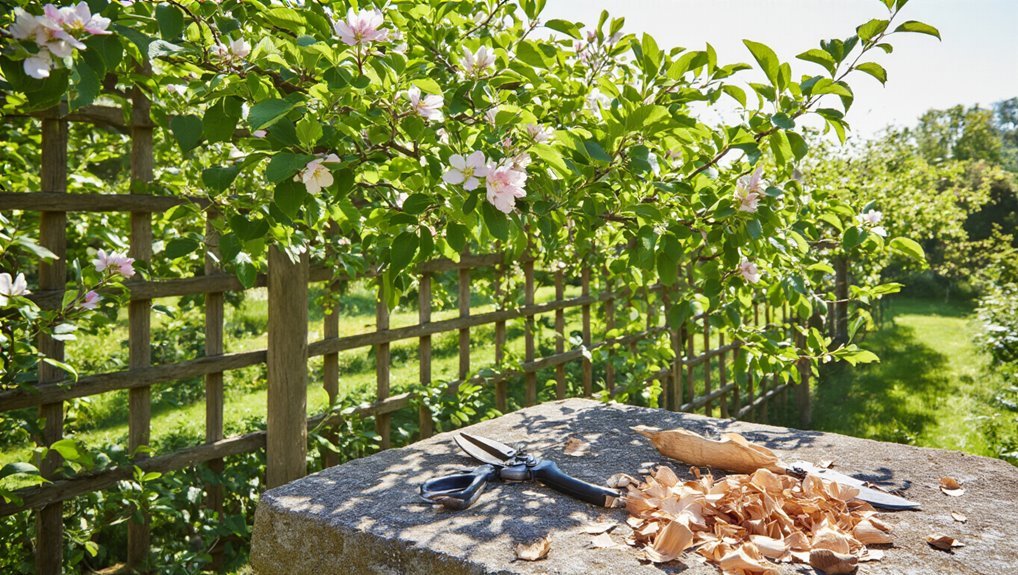
As you begin training and pruning your espalier fruit trees, remember that consistent attention is key to achieving the desired shape and maximizing fruit production.
Start by selecting a central leader and gently securing it to your support structure. Regularly remove unwanted shoots, focusing on lateral branches that will form the framework.
Prune during the dormant season to encourage healthy growth; cut back new growth to about one to three buds to stimulate branching. In the growing season, pinch back the tips of vigorous shoots to promote bushier growth.
Monitor for crossing branches and remove them to maintain airflow and sunlight penetration.
With patience and practice, you’ll create a stunning, productive espalier that enhances your garden space.
Maintenance and Care Requirements
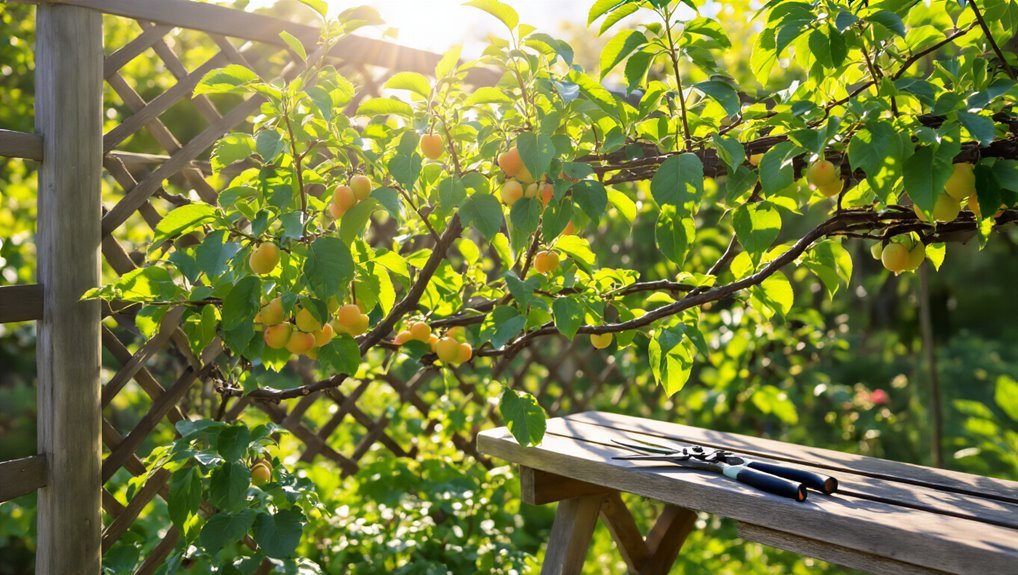
While you’re enjoying the beauty of your espalier fruit trees, consistent maintenance and care are essential for their long-term health and productivity.
Here are three key areas to focus on:
- Watering: Ensure your trees receive adequate moisture, especially during dry spells. Deep watering encourages strong root development.
- Fertilizing: Apply a balanced fertilizer in spring to promote growth and fruit production. Follow package instructions for best results.
- Pruning: Regularly check and prune your trees to maintain their shape and remove any dead or diseased wood. This helps encourage air circulation and sunlight exposure.
Common Pests and Diseases
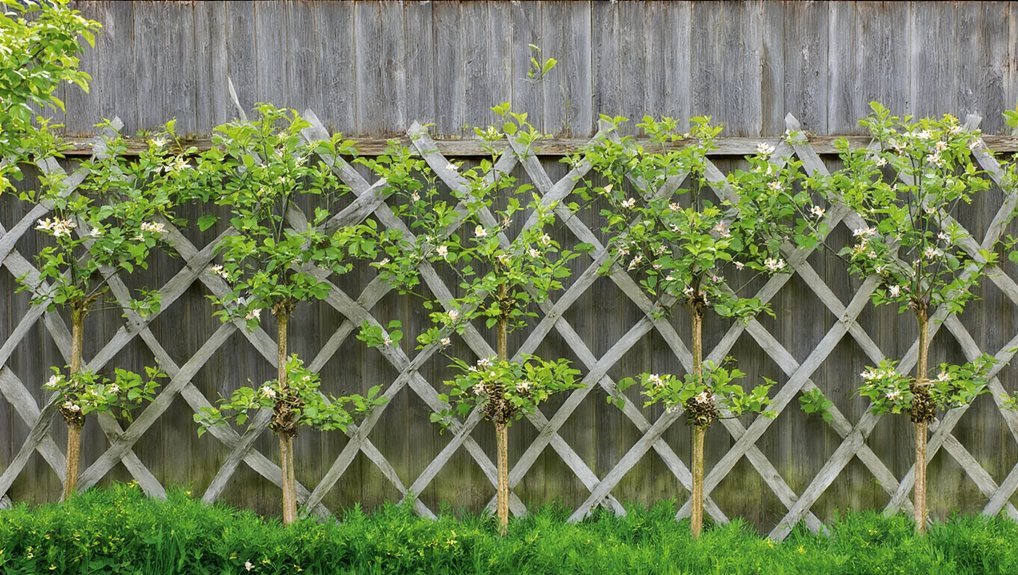
Healthy espalier fruit trees can fall victim to various pests and diseases, so it’s crucial to stay vigilant. Common pests include aphids, spider mites, and fruit flies, which can damage leaves and fruit.
Regularly inspect your trees for signs of infestation, like discolored leaves or sticky residue. If you spot pests, consider using insecticidal soap or neem oil to treat them effectively.
Diseases such as powdery mildew, fire blight, and root rot can also threaten your trees. To prevent these issues, ensure proper air circulation and avoid overwatering.
If you notice any symptoms, remove affected branches and apply appropriate fungicides. By staying observant and proactive, you can keep your espalier fruit trees healthy and productive.
Harvesting Your Espalier Fruit
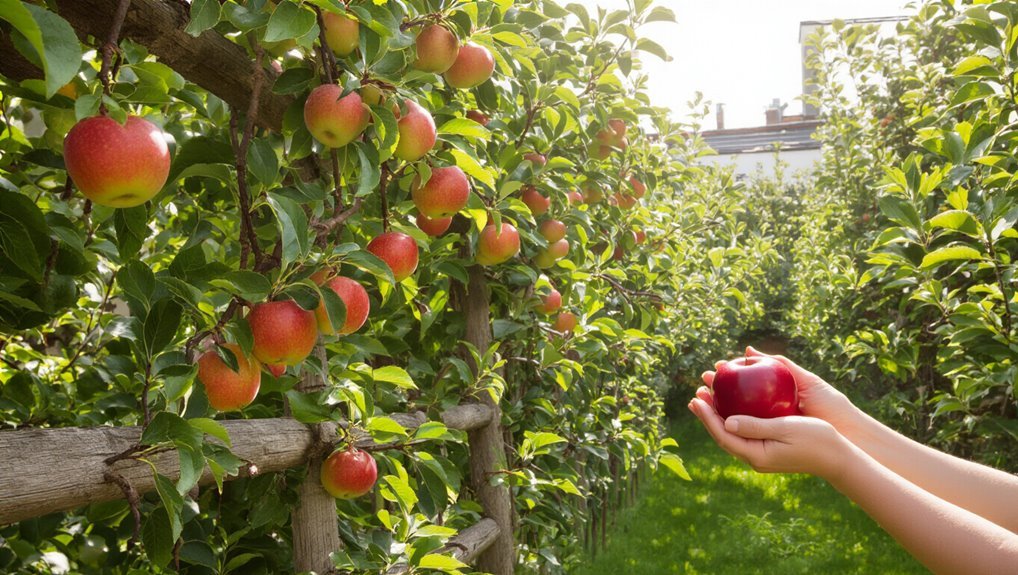
Timing is everything when it comes to harvesting your espalier fruit. To ensure you pick at the right moment, follow these simple tips:
- Check Color: Look for vibrant color in your fruit. For apples, a blush indicates ripeness, while peaches should be golden-yellow.
- Feel for Firmness: Gently squeeze the fruit. It should yield slightly but not feel mushy. Overripe fruit may fall off easily.
- Smell the Aroma: Ripe fruit often emits a sweet, fragrant aroma. If you can smell it from a distance, it’s likely ready to be picked.
Creative Design Ideas for Your Garden
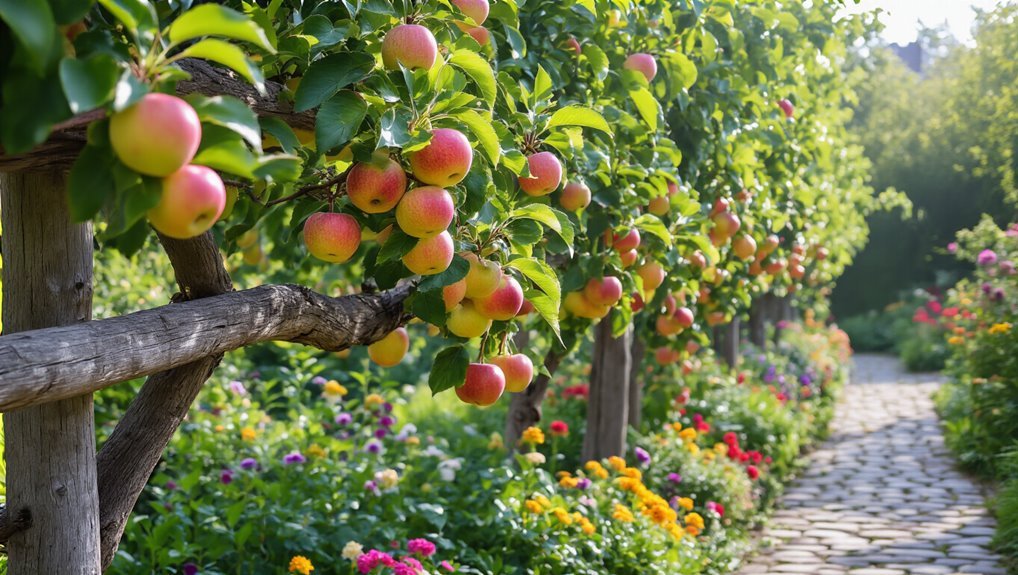
To elevate your garden’s aesthetic, consider incorporating creative design ideas that reflect your personal style.
Start by arranging your espalier fruit trees along a trellis or fence, creating a striking vertical element. Use colorful pots to introduce pops of color with flowers or herbs, enhancing the visual appeal.
Consider pathways made of gravel or stepping stones to guide visitors through your garden, adding texture and interest. Incorporate seating areas with benches or hammocks for relaxation, fostering enjoyment of your green space.
Don’t forget about lighting—string lights or solar lanterns can create a magical ambiance in the evenings.
Lastly, mix in ornamental grasses or perennials for year-round beauty, ensuring your garden remains vibrant and inviting throughout all seasons.
Frequently Asked Questions
Can I Grow Espalier Trees in Containers?
Yes, you can grow espalier trees in containers! Just choose a suitable dwarf variety, ensure proper drainage, and provide adequate support. Regularly monitor water and nutrients to keep your trees healthy and thriving.
How Long Until My Trees Start Producing Fruit?
Patience is a gardener’s best friend. Typically, you’ll see fruit from your trees within three to five years, depending on the type. Nurture them well, and they’ll reward you with delicious harvests soon enough!
Are There Specific Soil Requirements for Espalier Trees?
Yes, espalier trees thrive in well-draining soil that’s rich in organic matter. Aim for a slightly acidic to neutral pH, and ensure your soil retains moisture without becoming waterlogged. Regular testing helps maintain optimal conditions.
Can I Espalier Multiple Types of Fruit Trees Together?
Certainly, you can combine certain compatible fruit trees for a colorful, charming espalier display. Just ensure they share similar sunlight, soil, and watering needs to promote a flourishing friendship among your fabulous fruit varieties.
What Are the Best Practices for Winter Care of Espalier Trees?
For winter care of your espalier trees, you should protect them from harsh winds and freezing temperatures. Mulch around the base, prune before dormancy, and consider wrapping branches to prevent damage from extreme cold.
Conclusion
By growing espalier fruit trees, you’re not just saving space; you’re also adding a unique touch to your garden. With the right techniques and care, you’ll soon reap the fruits of your labor. Remember, patience is a virtue, and while it may take time for your trees to flourish, the rewards are well worth the wait. So, roll up your sleeves and get started—your beautiful, productive garden is just a few steps away!
